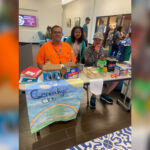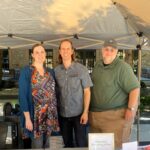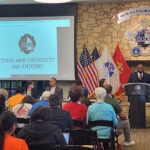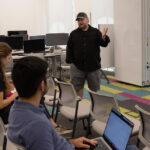
By Melody Mendoza
In response to a faculty complaint concerning crosses on the tower on University Way leading to Main Campus Building, President Maria Hernandez Ferrier said she is not going to suggest the crosses be removed.
She stated Nov. 7 the tower is built on developer-owned land that is separate from the university and the tower is a work of art.
An article in mysa.com Nov. 1 reported an objection by adjunct criminology Professor Sissy Bradford who said the crosses on the tower are inappropriate at a publicly funded institution.
But Ferrier said the crosses on the tower were neither appropriate or inappropriate because they are not a part of the university.
The tower was built on land owned by Verano Land Group, who donated almost 700 acres to Texas A&M-San Antonio. According to a Nov. 3 article on mysa.com, the City of San Antonio paid for the tower.
Marshal Lasswell, facilities and physical plant director, explained that the tower sits on a property median that divides two five-acre tracks that belong to the university.

According to gatewayplanning.com, the 10 acres are a “gateway property” divided evenly by University Way and are owned by Texas A&M-San Antonio, however the land on which the tower is built is owned by Verano.
Explaining the relationship between the university, Verano and its investors, Lasswell said, “Essentially, Verano donated land for us to build our campus. We had meetings where we conferred about the design of our building and they’ve discussed plans for development on their side.”
Although the university has a working relationship with Verano, Ferrier said she was not a decision maker in the tower’s decor. Lasswell also said the university does not have to abide by Verano’s architectural guidelines, and the A&M-University System has its own guidelines.
Ferrier said the tower is a work of art expressing the history and tradition of the South Side, which includes the Spanish missions, but said the tower doesn’t belong to the university.
When asked if she would put up a cross for decoration on campus, she said, “I probably wouldn’t.” But said if students wanted to display religious symbols for educational purposes, for example, during a holiday, she would allow it. She said she wouldn’t tolerate the disrespect of another person’s faith.
Ferrier said Bradford did not approach her with a concern about the tower, but said if faculty has a problem, “they should see their chair, then the school head, then the provost, then me.”
“If something is on their mind, I have an open door policy,” she said.
Bradford was vocal on the Mesquite-News and university Facebook pages, but denied an interview with a Mesquite reporter, indicating she felt it was necessary to speak up when she did to raise awareness, but the focus should be on student viewpoints, not her own.
“Now it is time for the campus community to carry the discussion forward,” she wrote via email Nov. 3.
In another email dated Nov. 9 she articulated her complaint, writing: “The issues are three. First, should there be a separation of church and state (First Amendment of the Constitution)? Second, if there should be a separation of church and state, should the city be funding crosses? And, should public state university seals be adjacent to crosses on public edifices displayed prominently on 410? Third, how do the crosses impact non-Christians members of our campus and in our community?”

Ferrier said the crosses on the tower do not fall into violation of separation of church and state which implies there cannot be a state religion.
“That doesn’t mean there can’t be symbols of expression of people’s faith,” she said. “Crosses on a work of art that express an area is not forcing any kind of religion on anyone.”
Ferrier said Verano consulted her in the designing of the tower to incorporate the university seal.
“They did come to me because they wanted permission to put our seal on the tower,” Ferrier said of Verano designers, but added that “on the drawings that they showed me, there were no crosses.”
Before she discovered the crosses, she said she had notified artist Jesse Carrera because the bell at the top of the tower wasn’t ringing.
She also suggested to “dampen” the color of the orange sunburst on the tower, which is Verano’s logo. “After all we are A&M not UT,” she laughed. On Nov. 7, the logos were painted black and affixed in their original location.
But the crosses on the tower were a surprise to her.
“When I saw them, I thought it was absolutely beautiful,” she said. “Not just because of my personal faith but because this entire university on the South Side is connected to the history of this part of San Antonio — and that is our missions.”
Verano’s Community Design Book makes a similar connection, stating “Verano sits in the midst of rich historical and cultural traditions, including Mayan and later Spanish settlements, which produced the beautiful plazas and buildings of the Missions District World Heritage Site just north of Verano.”
Ferrier added: “The cross is an integral part of the tradition and history of this area. So while I was not aware that they (crosses) were going to be there, I was delighted when I saw them because it’s just like the curvature, rose windows, iron bars, the doors; all of that is part of what the missions are.”
In response to students who may feel uncomfortable with the crosses, she said, “When you live in a country like ours where freedom of expression and art is a part of freedom of speech … then maybe all of us have some things that we don’t fully agree with.”
But, she said, that’s part of tolerance and living together in a free society, adding that, “I hope, regardless of race, religion, gender, that people walking onto this campus and meeting the people here will feel welcomed and embraced because that’s who we are.”
She said a person may feel uncomfortable about an artistic symbol because of their past experiences of the way people treated them. But later said, “All they have to do is walk in and feel the friendliness and openness of this university.”
“We are a university that embraces our students from all backgrounds and my hope is that they find their academic home here,” she said.
In a case when there was a controversial matter, Ferrier said she would consult students and staff when the decision has direct impact on students.
For example, if the state was about to make a major decision that would affect students or the university was deciding on which programs to offer: “Those are things that truly impact our students,” she said.
Bradford said some good has come from recent discussions and debates she initiated.
“When I first noticed the crosses, I was upset. I tried to ignore them. My conscience would not let me,” Bradford said via email Nov 9. “Several days later, I emailed my concerns to administrators.”
“I believe that our students are beginning to become aware of the issues. Learning to have civil discussions and respect for others is important at TAMU-SA and in the community,” she continued. “Having the opportunity to learn to speak thoughtfully, to hear others concerns and to consider relevant community issues prepares our students to participate in democracy.”
A week after the initial discussion, mention of the crosses has diminished.
In summarizing her stance, Ferrier said she’s focused on students’ education here.
She said personally, the university stands for two things: “Giving opportunity where there was none before” and “raising economic standard for our region.”
When students earn a diploma from A&M-San Antonio, Ferrier said she wants to ensure they have a job on the other end.
“The things, to me, that I am focused on is that you all get a world class education,” she said. An education that is “going to give you a well paying job … and give you the skills you need to leave the world better than you found it.”
Patricia Sierra Barrios contributed to this report.
Related article: http://www.mysanantonio.com/news/education/article/Crosses-stir-complaint-at-A-M-2247007.php#ixzz1dJPXnz3D






